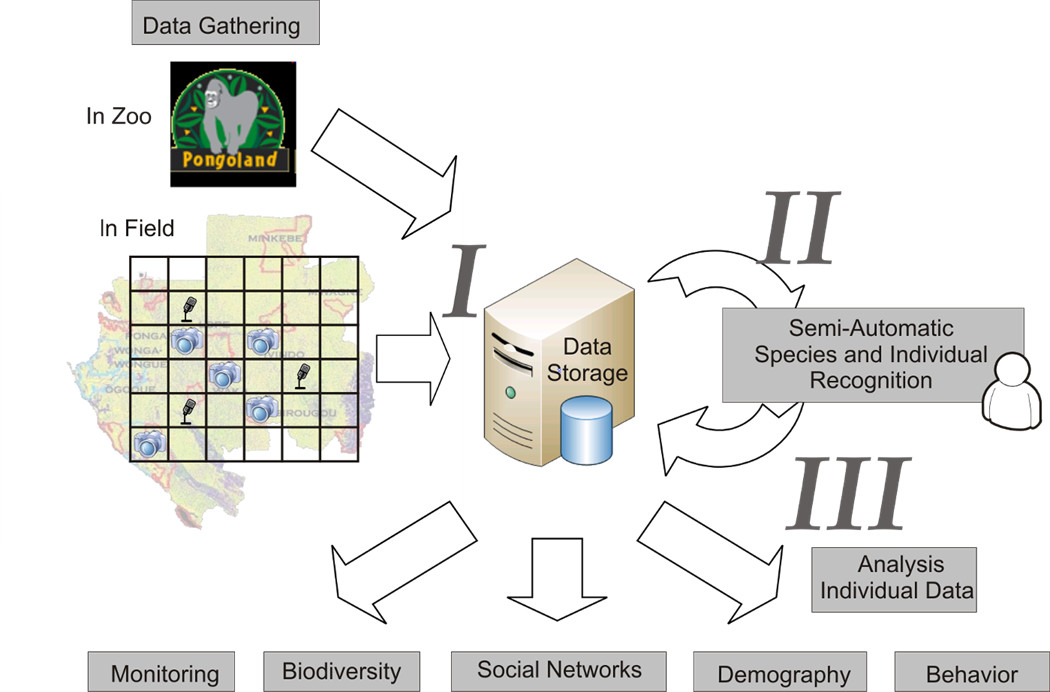
The objectives of this project were threefold:
- to collect high-quality visual and audio data to allow for the identification of species and individual animals,
- to develop procedures to allow the automatic identification of species, age and sex classes as well as individual animals from these data, and
- to substantiate the value of the approaches taken, with subsequent analysis of the processed data for conservation, behavioral and ecological research.
Our project focused specifically on the African great apes. Chimpanzees and gorillas are both threatened species and thus are the center of a number of conservation efforts, but they are also of particular interest to researchers of behavioral-ecology and human evolution. In addition, field ape research always suffers from the problem of limited sample sizes. This was because apes are rare and highly elusive, and in order to collect the necessary data, researchers are required to habituate them to human observers, a process which can take a number of years. Therefore, the development of a new approach providing larger sample sizes of ape observations would be highly valuable. However, in order to demonstrate the wide applicability of these potential approaches, we also included other apes (orangutans, gibbons, siamangs) and large mammal species (monkeys and elephants) in our study. The specific objectives of the proposed study are here presented in chronological order:
I. Collection of audio-visual data
- To evaluate in an experimental field study, which camera type, positioning and light conditions will maximize the quality of ape footage, and best allow automated identification of species, age, sex class, and individual.
- To collect long-term video and still-image-sequence-data of great apes and other large mammal fauna using remote camera traps in Loango National Park, Gabon.
- To evaluate the optimal placement and location of autonomous audio-recordingdevices.
- To collect long-term audio data on chimpanzees and gorillas using autonomous recording devices in Loango National Park, Gabon.
- To collect long-term video sequences of all four ape species in the Leipzig Zoo.
- To create a database for the storage of video-, still image-, audio-, and meta-data.
- To create reference datasets with large numbers of video sequences, still images, and audio recordings for known individuals of several species, e.g. chimpanzees and gorillas.
II. Semi-Automatic identification
- To modify existing algorithms for the efficient automatic extraction of the vocalizations of target species from long term-recordings.
- To evaluate classification algorithms in order to optimize the correct classification of species vocalizations.
- To modify existing approaches for the detection of individuals such as facial detection and multiple-object-tracking.
- To develop special visual features for species differentiation
- To modify and develop facial recognition techniques for the automatic recognition of individuals.
- To test the performance of algorithms designed for the identification of known individuals from long-term recordings
- To test the performance of algorithms designed for the identification of as-yet- unknown individuals
- To develop a graphical user-interface for human-computer-interaction
III. Analysis and Synthesis of processed individual data
In order to demonstrate the value of remotely-collected and subsequently processed audio-visual species data for use in conservation-monitoring, wildlife epidemiology and behavioral ecology research, we aim to conduct the following analyses:
- To modify and develop algorithms to establish social contact network structures from single time / point camera trap data, as well as automated probabilistic individual identification.
- To establish social contact network structures with data on individual apes derived from remote recording devices, both for within and between gorilla and chimpanzee communities, and the validation of identifications from direct observations.
- To establish transmission networks from contact network structures present in large mammal communities using camera-derived single time point data, and the validation of these networks using epidemiological data.
- To conduct time-series analyses of biodiversity data using remotely-recorded and automatically-processed audio and visual data, and compare the efficiency of those results with traditional methods.
- To conduct demographic data-analyses using automatically-processed field recordings of great apes, including the determination of age and sex class structure, as well as age and sex class-specific survival-probability, and the validation of this data with direct observation data.
- To modify existing approaches in population size estimation (accumulation curve methods, capture-mark-recapture techniques) as to include uncertainty in individual identification from automated processes, and apply it to the processed data.
- To analyze processed sequences from video recording in Leipzig Zoo with regard to visitation rate of feeding dishes, location of drumming individuals, and fighting individuals.
 Fraunhofer Institute for Digital Media Technology IDMT
Fraunhofer Institute for Digital Media Technology IDMT